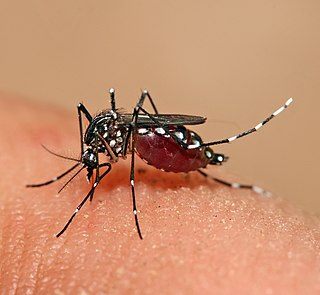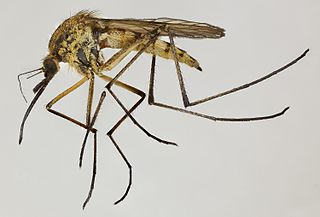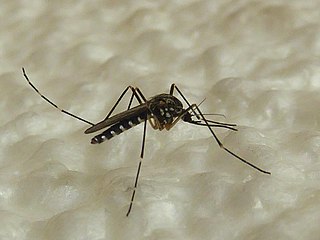
Mosquitoes are approximately 3,600 species of small flies comprising the family Culicidae. The word "mosquito" is Spanish for "little fly". Mosquitoes have a slender segmented body, one pair of wings, one pair of halteres, three pairs of long hair-like legs, and elongated mouthparts.

Aedes albopictus, from the mosquito (Culicidae) family, also known as the (Asian) tiger mosquito or forest mosquito, is a mosquito native to the tropical and subtropical areas of Southeast Asia. In the past few centuries, however, this species has spread to many countries through the transport of goods and international travel. It is characterized by the white bands on its legs and body.

Aedes is a genus of mosquitoes originally found in tropical and subtropical zones, but now found on all continents except Antarctica. Some species have been spread by human activity: Aedes albopictus, a particularly invasive species, was spread to the Americas, including the United States, in the 1980s, by the used-tire trade.
La Crosse encephalitis is an encephalitis caused by an arbovirus which has a mosquito vector.

Aedes aegypti, the yellow fever mosquito, is a mosquito that can spread dengue fever, chikungunya, Zika fever, Mayaro and yellow fever viruses, and other disease agents. The mosquito can be recognized by black and white markings on its legs and a marking in the form of a lyre on the upper surface of its thorax. This mosquito originated in Africa, but is now found in tropical, subtropical and temperate regions throughout the world.

The Culicinae are the most extensive subfamily of mosquitoes (Culicidae) and have species in every continent except Antarctica, but are highly concentrated in tropical areas. Mosquitoes are best known as parasites to many vertebrate animals and vectors for disease. They are holometabolous insects, and most species lay their eggs in stagnant water, to benefit their aquatic larval stage.

Aedes rusticus, it is a relatively common European mosquito, that is often responsible for human bites from May to August. Like all mosquitoes, it is only the females that bite.
Ochlerotatus is a genus of mosquito. Until 2000, it was ranked as a subgenus of Aedes, but after Reinert's work, the clade was upgraded to the level of a genus. This change has resulted in the renaming of many subgenus species, and many aedini-related taxa are undergoing taxonomic revisions. Some authors are still using traditional taxonomic names in their publications.

Aedes triseriatus is a member of the true fly order. It is called the eastern tree hole mosquito due to its predilection towards breeding in stagnant water that is found in natural holding containers such as tree holes. It is native to the eastern United States and southern Canada and favors hardwood habitats. It has been found as far south as the Florida Keys, as far west as Idaho and Utah, and as far north as Quebec and Ontario. This species has not yet been found in Europe, but it has the potential to spread through international trade. In 2004, it was found in a shipment of tires travelling from Louisiana to France, but it was identified and targeted with insecticides that truncated its spread. It is a known vector of La Crosse encephalitis and canine heartworm disease. In the laboratory, it has been found to vector several other viruses including yellow fever, eastern encephalitis, Venezuelan encephalitis, and western encephalitis. Because of its potential for international spread and its proclivity for transmitting disease, monitoring the distribution of this species is essential.
Aedes capensis is a species of mosquito primarily found in forests in sub-Saharan Africa.

Aedes canadensis, the woodland pool mosquito, is an aggressive, day biting mosquito that can be a vector of a number of diseases which is found mainly in eastern North America.
Aedes vittatus is a species of mosquito that was first described in 1861 as Culex vittatus from specimens collected on Corsica. In 2000, the species was transferred to the newly erected subgenus Fredwardsius as the type species representing the subgenus.
Aedes luteocephalus is an African species that is a demonstrated or suspected vector of several important arboviral diseases of humans. First described in 1907 as Stegomyia luteocephala, the species is currently classified in the genus Aedes, subgenus Stegomyia.
Aedes malayensis was first described in 1963 by Australian entomologist Donald Henry Colless as a subspecies of Aedes scutellaris from males collected at Pulau Hantu, Keppel Harbor, Singapore. In 1972 the subspecies was elevated to species status by Yiau-Min Huang, although the move was disputed by the original describer on biological as opposed to morphological principles.

Commonly known as the Korean bush mosquito, Ae. koreicus adults are relatively large with a black and white pattern on their legs and other body parts. Clear longitudinal lines on the dorsal part of the thorax distinguish it from Ae. aegypti and Ae. albopictus. The species bears close morphological, ecological, and genetic similarity to the Asian bush mosquito, Aedes japonicus, but can be physically distinguished by a pale basal band on the hind tarsomere.

Aedes japonicus, commonly known as the Asian bush mosquito or the Asian rock pool mosquito, was first described by Theobald in 1901 from Tokyo, Japan. They are competent arbovirus vectors known to transmit the West Nile virus as well as Japanese and St. Louis encephalitis. They are listed as an invasive species by the Global Invasive Species Database.

Skusea is a mosquito genus in the family Culicidae. Before the reclassification of aedine genera, Skusea pembaensis was known as Aedes pembaensis.
Aedes scatophagoides is a species complex of zoophilic mosquito belonging to the Mucidus Group of the genus Aedes.

Aedes taeniorhynchus, or the black salt marsh mosquito, is a mosquito in the family Culicidae. It is a carrier for encephalitic viruses including Venezuelan equine encephalitis and can transmit Dirofilaria immitis. It resides in the Americas and is known to bite mammals, reptiles, and birds. Like other mosquitoes, Ae. taeniorhynchus adults survive on a combination diet of blood and sugar, with females generally requiring a blood meal before laying eggs.

Aedes scapularis is a species of mosquito primarily found in neo-tropical regions of the Americas.












